#daniel warner attorney
Explore tagged Tumblr posts
Text
2024 TV Season Analysis – Organized Crime Tops the Franchise, Law & Order Better, SVU Needs an Overhaul
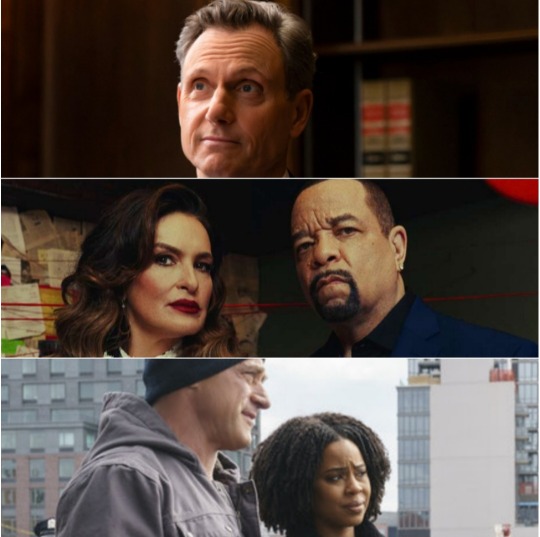
The 2023-24 TV season has been a truncated TV season of 13 episodes, due the ongoing WGA/SAG-AFTRA strikes that happened last year. A lot of scripted TV was back burned until the strikes ended. TV writers struck their deal first and were back to work promptly, long before actors/actresses, this should have given time to plan out their already short season. Production crunched for 13 episodes to be shot between late November until this coming week, where SVU and mother ship reboot will be wrapping up shooting their finale episodes.
But where does this season grade in its entirety? I’m going to summarize – as much as I can - my views on where the franchise stands for this season from best to worst. Click below to read.
Organized Crime – The best in the franchise creatively, hands down!
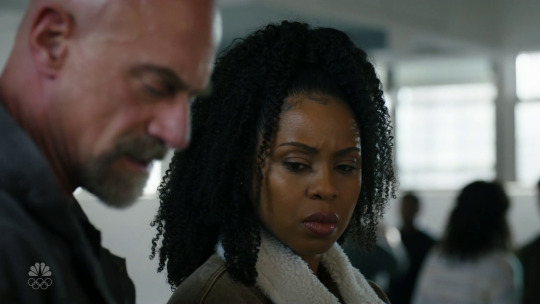
New show runner/executive producer John Shiban (The X-Files) and his writing staff understood their assignment and have definitely delivered. Organized Crime is the most entertaining series in the franchise this season, week-over-week. The storylines are so fleshed out and they don’t drag on as they had since the series started. Shiban has shifted focus to the OC main characters and their backstories as well as expanding on the OC unit in its entirety. We’ve even seen 2 of SVU’s former stars show up (Tamara Tunie, Chief M.E. Melinda Warner / Dann Florek, Donald Cragen) as well as an appearance by Peter Scanavino (ADA Dominick Carisi). We have even been introduced to more of Stabler’s family, his brothers – portrayed by guest stars Dean Norris and Michael Trotter – and while they’ve come in and shook things up for Stabler, one thing I can point out, it’s the first season since OC premiered where I haven’t felt that Elliot Stabler is on a quest for vengeance or retribution of some kind.
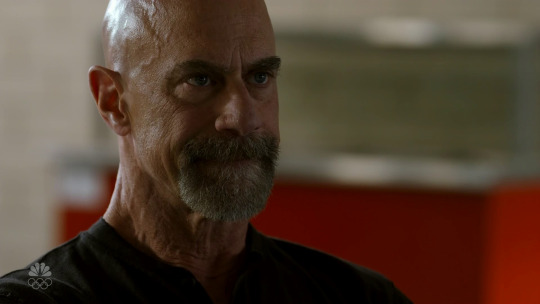
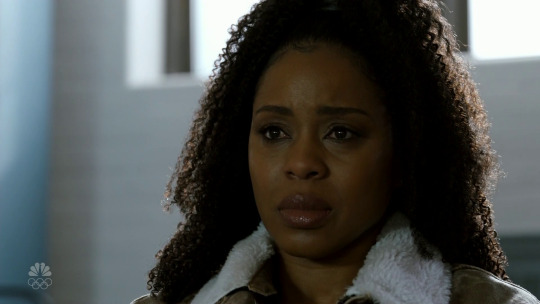
The cast has been firing on all cylinders this season, especially with the episode that just aired last week (“Crossroads”), where one of OC’s new team members went missing and was found to be killed, Stabler having the bury his body as he is undercover with the group that found Detective-in-Training Samir Bashir (guest star Abubakr Ali). This story is still playing out so as of now we don’t fully know who killed him but I’m sure we’re about to find out. Stabler’s younger brother, Joe Jr. may have some involvement as the investigation is about to come full circle. Meanwhile, the scene in question in this episode has Christopher Meloni and Danielle Mone Truitt deliver their most powerful scene together yet in the series and they have delivered quite a few, this one stands out though.
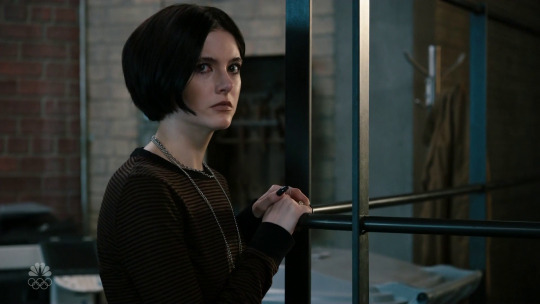

Excellent only begins to describe it, and Organized Crime this season. Organized Crime has yet to be renewed for the 2024-25 TV season.
Law & Order (reboot) – It’s improved, but we still have a ways to go.
There is a lot to be said of the mother ship series, both the original and this reboot. But this reboot has seen a lot in its short time on air, in this short season alone the cast has changed twice already. Jeffrey Donovan (Detective Frank Cosgrove) and the series parted ways weeks before production was set to start and veteran Sam Waterston (District Attorney Jack McCoy) chose to depart before mid-season. Sam Waterston is/will greatly be missed and he leaves behind a full legacy on the show, which he joined in 1994! Meanwhile newcomers Reid Scott (Detective Vincent Riley) and Tony Goldwyn (District Attorney Nicholas Baxter) have been welcomed by fans with open arms. The cast of the reboot no matter which season is very solid and they are all very talented, but their talents often seem crippled.
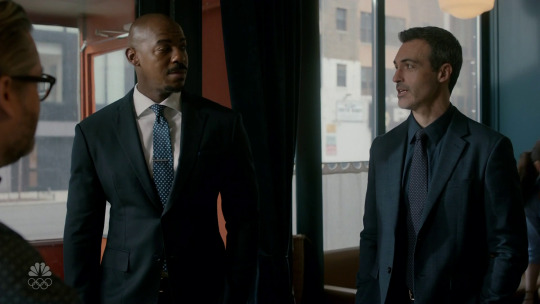
The reboot seems to have an issue fleshing out the characters. Det. Jalen Shaw (Mehcad Brooks) and ADA Sam Maroun (Odelya Halevi) – and add DA Nick Baxter (Goldwyn) to me, week-in and week-out are the unsung heroes as with them we can see depth, we can understand why they make the decisions they make or feel the way they do on certain topics. I’m still on the fence about Riley’s development but he’s definitely has a more solid partnership with Shaw than Cosgrove did, and he certainly is a better character. I think they’ve got a great detective duo here – reminiscent of that of Ed Green (Jesse L. Martin) and Cyrus Lupo (Jeremy Sisto) in season 18. From about the third episode this season on up, there has been an improvement in the writing, I must say in comparison from where the season started. Most of the episodes this season seem to have one singular writer who stands out, Pamela Wechsler, who also serves as executive producer. Girl power!
What can help the reboot:

The writers need to get away from talking points and political affiliation when it comes to the characters and even the weekly storylines - looking at you show runner Rick Eid - it makes the characters come off as caricatures and stereotypes. And maybe not directly rip the episodes from the headlines near verbatim. It takes away from it if we already know how it plays out – where is “the Law & Order twist?” They need to deep dive into Vincent Reilly, Nolan Price (Hugh Dancy) and Kate Dixon (Camryn Manheim); we have talented actors on here, give them something that makes us stand up and clap and relate to these characters and stop making them one-dimensional, especially ADA Price. I must say I’ve been enjoying the legal side a bit more with the addition of Goldwyn’s Baxter, his back-and-forth every week with Price has a feel of the original series run, where we see multiple points of views on cases and it doesn’t feel/sound like rhetoric. And speaking of that run, it wouldn’t hurt for them to find ways to invest those old characters in the reboot. Just because Sam has departed doesn’t mean we still don’t want to see old faces or even faces from the other L&O series show up. Elisabeth Rohm (ADA Serena Southerlyn) and Milena Govich (Det. Nina Cassady) have directed episodes! Raul Esparza and Hugh Dancy both starred in Hannibal, I could see former-ADA now Defense Attorney Rafael Barba sitting at the defense table and likely wiping the floor with Price! Tony Goldwyn even wants Mariska Hargitay to direct an episode. Let’s make the mother ship enjoyable to watch again!
It was renewed for a 24th season (4th for the reboot). The mother ship has a second chance at greatness and to continue its legacy on television, not a lot of shows get that. It would be wise that those in charge on mother ship remember that.
SVU – The 25th milestone season ranks as one of the worst.
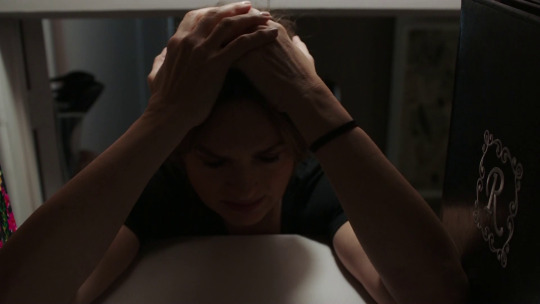
I originally had a two-page long document on this season of SVU alone and I’ve had to shorten it down and it’s still not that short. But if I had to describe the 25th record-breaking season of SVU in 1 word, that word would be “bad.” There are calls on social media for show runner/executive producer David Graziano to be fired from the series. I’m not one to openly call for people to lose their jobs, but clearly there is something wrong and the downward spiral of the ratings mixed with bad press for SVU episodes this season is showing that. Nothing about season 25 jumps out as milestone season and there are only a handful of episodes as of now, that I would consider episodes worth going back to watch again: “Tunnel Blind”, “Duty to Report”, “Probability of Doom”, and “Children of Wolves” which was directed by Mariska Hargitay.
It’s the writing and direction of this season, period. There is no other reason or excuse that flies. There is clearly no investment from the management level behind the scenes at SVU in this milestone season being the best it could have been. The Maddie storyline overtook the season and its resolution didn’t exactly hit the mark either. Where is the retrospective? Why haven’t we gone over past cases? Seen former victims/survivors (other than 2 minutes worth of Maria from “911”)? Why did Olivia stop seeing Dr. Lindstrom (Bill Irwin)? Where is the ‘healing?’ The guest stars? We haven’t seen any former stars, other than Kelli Giddish (Detective Amanda Rollins), and that proves to me that it was a mistake to fire her in the first place. “Where is the energy? Where is the spatter? This is life-less dreck. A cheap knock-off…” (diehard SVU fans; if you know, you know). But seriously, nothing about this season overall screams “25 years!”
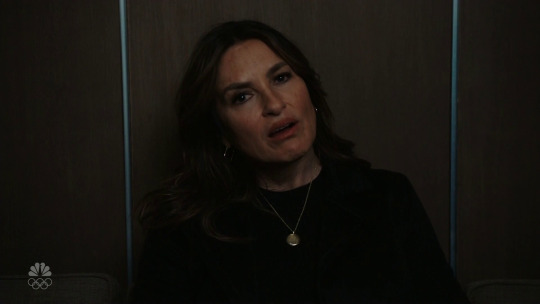
With the season opener, I was sure David Graziano and the writers turned the page on the mess that was most of the entire 24th season of SVU. Turns out I was wrong to think it. It seems to be doubled down. It’s proof that despite his behavior, he’s just not a good fit for SVU. He doesn’t seem to understand how to write for this show and be the voice of who women/people look up to and the voice that victims and survivors need. I honestly think he would serve better on a Criminal Intent reboot or something since he seems to like that aspect of the crimes more so than investigatory and the legal side – Peter Scanavino’s screen time has greatly decreased and well as legal scenes.
What can help SVU:
A lot of damage is done, but it’s not irreversible. The best call is to replace the person at the top if they aren’t going to change themselves, (sorry but not sorry David). The popular eras of SVU are seasons 3-7 and again 13-17 and for good reason; Neal Baer and Warren Leight remain the two people who have seen SVU at their peaks. Going into a record breaking season 26, someone who can understand the intricacies of SVU needs to take the helm and get this show turned around. Focus needs to be on steadying the storylines and fleshing them out in a meaningful way to where they connect and not have crucial bits just disappear into thin air. We need to get SVU’s focus back on uplifting the voices of victims and survivors and their journeys, as well as to delve deep again into the world of the NYPD SVU squad. It’s not just about “rape case of the week” the actual SVU deals with kidnappings, crimes against the children, the disabled/elderly, working in conjunction with the Hate Crimes unit/federal govt., trafficking and more, let’s get the variety back in the crimes – and let’s stop showing the crime taking place on screen and in graphic manner. The crime scene analysis, forensics, court scenes and legalese needs to be put back into this series, I’ve honestly felt it decrease even before S24 as far back as some S22.

We need to see Carisi navigate through these cases and the back-and-forth with the defense as well as in his own bureau. We’ve yet to see Carisi interact with the district attorney (Jack McCoy, Sam Waterston – now Nick Baxter, Tony Goldwyn) much like his preceding ADAs. Benson’s character needs to go back to therapy and deal with her issues head on (Lindstrom, Bill Irwin), she had done that up until EDMR in season 24 became her new way and it’s not working for her, since the writers seem to use it now as a crutch to say “she’s healing” but then turn around and have her do things to suggest otherwise. Benson also needs to be written as a leader and delegator more so than taking every case away from her “squad” and solving them personally. Actually from a story standpoint it would be great to see Benson face repercussions for continually doing this, in the real world that would have consequences as how can she personally investigate cases and run the unit?
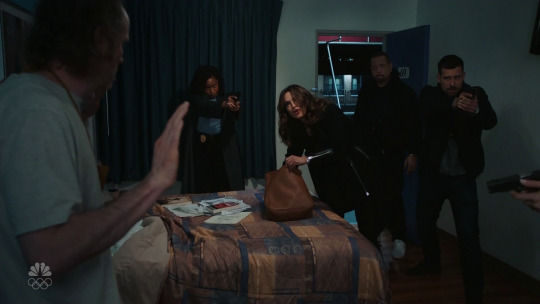
And with the unit, their stories need to be dissected more. Velasco (Octavio Pisano) in particular, he had an edge in season 23 as the new guy that might be a snitch for the Chief of Detectives (McGrath, Terry Serpico) but in season 24 they pushed this character into a corner with liking Detective Grace Muncy (Molly Burnett, who departed last season) and the Chilly storyline last season and can’t seem to get him out of that corner. Velasco comes off as “just there” much in the way Fin (ICE T) is starting to. And where is Phoebe (Jennifer Esposito)? Detective Bruno and Captain (to-Detective or Chief?) Curry (Kevin Kane and Aime Donna Kelly) are pretty much holding down the squad and are actually the more I look to, to solve the cases and they are the only ones peaking my interest.
SVU is heading to record-breaking season 26, if they want to reach their goal of stopping at 30. Dick Wolf, NBC and those behind the scenes need to get serious about it if that is what they really want. Otherwise, you’re about to have long-time viewers and new viewers alike turning away. Despite what people believe about ever-lasting loyalty, it does have an end date.
What do you think? Do you agree or disagree? Feel free to respond!
#Law & Order#Law & Order: SVU#SVU#Law & Order: Organized Crime#Organized Crime#OC#L&O#NBC#Mariska Hargitay#Hugh Dancy#Tony Goldwyn#Christopher Meloni#Peter Scanavino#Kelli Giddish#Olivia Benson#Sam Waterston#Amanda Rollins#Dick Wolf#Mehcad Brooks#danielle moné truitt#odelya halevi#law & order: special victims unit#David Graziano#Rick Eid
19 notes
·
View notes
Text

Bisan Owda is a journalist in Gaza that keeps updating about the barbaric genocide actions that israel committed with weapons supplied mainly by US, all the while living through that genocide itself.
Over 30k+ has been killed, and over 15k+ of those are children and babies.
The celebs and artists who wanted to rescind Bisan's nomination are as follow:

Ari Ingel, Executive Director, Creative Community for Peace
David Renzer, Former Chairman/CEO Universal Music Publishing Group, CCFP Chairman & Co-Founder
Steve Schnur, Worldwide Executive & Music President, Electronic Arts, CCFP Co-Founder
Rakefet Abergel, Actor/Director, Cyclamen Films
Orly Adelson, Former President of ITV Studios, America
Marty Adelstein, CEO, Tomorrow Studios
Anne-Marie Asner, Co-Founder, Animation Israel
Jeff Astrof, TV Producer/Showrunner, Other Shoe Productions
Michael Auerbach, Partner, Jackoway Austen Tyerman Wertheimer Mandelbaum Morris Bernstein Trattner Auerbach Hynick Jaime LeVine Sample & Klein
Dean Bahat, Attorney, Ziffren Brittenham
Andrea Ballas, VP Comms, CBS
Jackie Barrie, A&R Manager, Nvak Collective
Richard Baskind, Partner & Head of Music, Simons Muirhead & Burton
Aton Ben-Horin, Executive VP of Global A&R, Atlantic Records Group
Steven Bensusan, President, Blue Note Entertainment Group
Adam Berkowitz, Founder and President, Lenore Entertainment Group
Sharon Bialy, Casting Director, Bialy/Thomas & Associates
Josh Binder, Co-Founder and Partner, Rothenberg Mohr & Binder, LLP
Neil Blair, Founding Partner, The Blair Partnership
Selma Blair, Actress, Author, Advocate, Sainted Productions
Rebecca Blumberg, SVP Ad Sales, Paramount
Evan Bogart, Songwriter & CEO, Seeker Music
Benjamin Budde, CEO, Budde Group GmbH
Bruce Burger, Producer, RebbeSoul
David Byrnes, Attorney, Ziffren Brittenham
Civia Caroline, Social Impact Consultant, CLiC Impact
Pamela Charbit, Director of A&R, Warner Music Group
Emmanuelle Chriqui, Actor, Yellow Ray Entertainment
Leanne Coronel, Talent Manager, The Coronel Group
Raye Cosbert, Managing Director, Metropolis Musi
Paul Craig, Ceo, Nostromo Management
Doug Davis, NATAS Member, 2x Emmy winner, The Davis Firm
Rebecca De Mornay, Actor
Jamie Denbo, Co-Executive Producer, Grey’s Anatomy, ABC/Disney
Josh Deutsch, Chairman/CEO, Premier Music Group
Avi Diamond, Director, Film/TV Sync, Warner Music Canada
Craig Dorfman, President and Owner, Frontline MGMT
Rachel Douglas, Manager, Range Media Partners
David Draiman, Frontman, Disturbed
Jeremy Drysdale, Screenwriter, bigbamboo
Craig Emanuel, Ryan Murphy Productions
Hannah Epstein, Agent, CAA
Rami “Kosha dillz” Even-Esh, Rapper/Comic/Actor
Lindsay Fabes, Actor
Ron Fair, Record Producer & CEO, Faircraft Inc.
Sharon Farber, Composer, Score by Score Music
Danny Federman, Owner, Maccabi Tel Aviv Basketball Club
Eric Feig, Attorney and TV Academy Member, Feig/Finkel
Patti Felker, Attorney, Felker Toczek Suddleson McGinnis Ryan LLP
Ken Fermaglich, Partner, United Talent Agency
Ross “Remedy” Filler, Artist
Shalom Fisch, President, MediaKidz Research & Consulting
David Fishof, CEO, RRFC Films, LLC
Siri Garber, Publicist, Platform
David Gardner, President, Artists First
Barbara Garshman, CEO, Garshman Productions LLC
Gary Gersh
Gary Ginsberg, Senior VP, SoftBank Group Corp.
Brian Ralston, Composer/Producer, Studio 74 Music, LLC
David Glick, Founder & CEO, Edge Group
Zusha Goldin, Celebrity Photographer, Zusha Goldin
Michael Goldwasser, President, Easy Star Records
Andrew Gould, President, Music Publishing
Scott Greenberg, Partner, LBI
Steven Greenberg, Founder and President, S-Curve Records
Daniel Grindlinger, Writer
Ronnie Harris, Partner, Harris & Trotter
Michael Hirschhorn, Manager, Streaming and Sales, Atlantic Records
Linda Edell Howard, Attorney, Novick Law
Rich Ingram, Artist/Creator
Neil Jacobson, Former President, Geffen Records, Founder & CEO of Hallwood Media
Michael Kaplan, Writer/Producer
Sam Katz, Music Manager, Homebase MGMT, LLC
Zach Katz, CEO & Co-Founder, Fixated
Ketura Kestin, Film Producer, Serendipity Productions
Amanda Kogan, Manager, Aaron Kogan Management
Keetgi Kogan Steinberg, Writer/Producer/Showrunner
Jason Kozel, Creative Executive, Range Media Partners
Rick Krim, CEO, Krim Music + Media
Evan Lamberg, President, North America, Universal Music Publishing Group
Sherry Lansing, Former CEO, Paramount Pictures
Colin Lester OBE, Founder/Chairman, JEM Music Group
Sean Liebowitz, Agent
Koura Linda, Founder & CEO, Space Dream Productions
Marci Liroff, Intimacy Coordinator/Casting Director
Cory Litwin, Managing Partner, Range Media Partners
David Lonner, CEO, The David Lonner Company
Ben Maddahi, President, Unrestricted Publishing & Mgmt
Gabriel Mann, Composer
Deborah Marcus, Executive, CAA Foundation
Susan Markheim, Full Stop Mgt., The Azoff Company
Amanda Markowitz, Actor/Producer, SAG/AFTRA & PGA
Orly Marley, President, Tuff Gong Worldwide
Devra Maza, Screenwriter
Debra Messing, Actor/Producer
Hilary Michael, Agent and Partner, WME
Beth Milstein, Writer
Jennifer Morrow, Actor, CAA
Patrick Moss, Writer, Moroccan Boychik
Robert Munic, Writer/Showrunner, Pull The Pin Productions, Inc.
Lisa Nupoff, Manager, iminmusic management
Scott Packman, Founder and Managing Member, SSP Partners LLC
Mark Pinkus, President, Rhino Records
Jonah Platt, Actor/Producer
Wendy Plaut, SVP Music & Celebrity Talent, Paramount Global
Jessica Poter, Writer, Gustavo Anibal Productions
Golan Ramraz, Writer/Producer, EGX Film Factory
Bruce Resnikof
Frederic Richter, Producer, Writer & Researcher
Wendy Robbins, Executive Producer, Creators Inc
Dan Rosen, President, Warner Music Australasia
Rick Rosen, Co-Founder, Endeavor, WME
Aaron Rosenberg, Partner, Myman Greenspan Fox Rosenberg Mobasser Younger & Light
Gregg Rossen, Screenwriter
Michael Rotenberg, CEO, 3 Arts Entertainment
Joshua Rothstein, CEO/Founder, Ice Cream For Dinner
Haim Saban, Chairman and CEO, Saban Capital Group
Glenn Sanders, Writer/Director/Creative Director, Masonry Creative
Ayelet Schiffman, SVP Head of Promotions, Island Records
Paul Schindler, Senior Partner, Greenberg Traurig LLC
Jordan Schur, CEO and Chairman, Mimran Schur Pictures and Suretone Entertainment
Adam Schwartz, Writer
Sam Schwartz, Partner, Gorfaine/Schwartz Agency
Jay Schweid, Founder/CEO, ephelants/Village
Adam Segal, President, The 2050 Group
Ben Silverman, Chairman and Co-CEO, Propagate Content
Ralph Simon, Chairman & Chief Executive Officer, Mobilium Global Limited
Tamar Simon, Owner/CEO, Mean Streets Management
Martin Singer, Attorney, Lavely and Singer
Halle Stanford, President of Television, The Jim Henson Company
Mimi Steinberg, Writer/Producer
Jonathan Steinsapir, Partner, Kinsella Holley Iser Kump Steinsapir
Gary Stiffelman, Founder, GSS Law
Traci Symanski, CEO, Co-Star Entertainment
Aaron Symonds, Film Composer
Fernando Szew, President, Fox Entertainment
Tal Tavin, Actor
Adam Taylor, President, APM Music
Michael Testa, Casting Director, Michael Testa Casting
Fred Toczek, Partner, Felker Toczek Suddleson Abramson McGinnis Ryan LLP
Eric Tuchman, Writer/Producer, MGM-TV
Noa Vinshtok, Streaming, Range Media Partners
Joshua Washington, International Recording Artist, JoDavi Music LLC
Avi Weider, Filmmaker, Loop Filmworks
Jon Weinbach, President, Skydance Sports
Nola Weinstein, Tech Executive
Ilana Wernick, Writer/Producer, Fox
Modi Wiczyk, Co-Founder, MRC
Evan Winiker, Managing Partner, Range Music
Seth Yanklewitz, Casting Director, Yanklewitz Pollack Casting
Sharon Tal Yguado, Founder & CEO, Astrid Entertainment
Ky Zaretsky, Manager, Range Media Partners
David Zedeck, Global Co-Head of Music
[Sources: here, here, and here]
#palestine#from the river to the sea palestine will be free#gaza#free gaza#save palestine#palestine news#free palestine#palestinian genocide#gaza news#gaza genocide#stop genocide#genocide#stop the genocide#emmys#emmy awards#america#usa news#usa#celebrities#hot celebs#celebs#celebrity#sexy celeb#taylor swift#taylorswift#ariana grande#arianator#swifties
12 notes
·
View notes
Text
The Saturns, which honor the best in genre entertainment across film and television, are organized by the Academy of Science Fiction, Fantasy and Horror. Winners will be announced February 4, 2024 in a ceremony at the LA Marriott Burbank Airport Hotel and will stream live on ElectricNow.
Best Action / Adventure Film
Bullet Train (Sony Pictures) The Equalizer 3 (Sony Pictures) Fast X (Universal Pictures) John Wick: Chapter 4 (Lionsgate Films) Mission: Impossible – Dead Reckoning Part One (Paramount Pictures) The Woman King (TriStar Pictures)
Best Film Screenwriting
Avatar: The Way of Water, James Cameron and Rick Jaffa & Amanda Silver (Walt Disney/Lightstorm) Barbie, Noah Baumbach & Greta Gerwig (Warner Bros. Pictures) The Menu, Seth Reiss & Will Tracy (Searchlight Films) Mission: Impossible – Dead Reckoning Part One, Erik Jendresen & Christopher McQuarrie (Paramount Pictures) Oppenheimer, Christopher Nolan (Universal Pictures) Pearl, Ti West & Mia Goth (A24)
Best Film Editing
Avatar: The Way of Water, Stephen Rivkin, David Brenner, John Refoua, James Cameron (Walt Disney/Lightstorm) Fast X, Dylan Highsmith, Kelly Matsumoto, Corbin Mehl, Laura Yanovich (Universal Pictures) Indiana Jones and the Dial of Destiny, Andrew Buckland, Michael McCusker, Dirk Westervelt (Lucasfilm/Paramount/Disney) John Wick: Chapter 4, Nathan Orloff (Lionsgate Films) Mission: Impossible – Dead Reckoning Part One, Eddie Hamilton (Paramount Pictures) Oppenheimer, Jennifer Lane (Universal Pictures)
Best Film Visual / Special Effects
Avatar: The Way of Water, Joe Letteri, Richard Baneham, Eric Saindon, Daniel Barrett (Walt Disney/Lightstorm) The Creator, Jay Cooper, Ian Comley, Andrew Roberts, Neil Corbould (20th Century Studios) Guardians of the Galaxy-Vol. 3, Stephane Ceretti, Alexis Wajsbrot, Guy Williams, Dan Sudick (Marvel/Walt Disney Studios) Indiana Jones and the Dial of Destiny, Andrew Whitehurst, Kathy Siegel, Robert Weaver, Alistair Williams (Lucasfilm/Paramount/Disney) Mission: Impossible – Dead Reckoning Part One, Alex Wuttke, Simone Coco, Jeff Sutherland, Neil Corbould (Paramount Pictures) Oppenheimer, Andrew Jackson, Giacomo Mineo, Scott Fisher, Dave Drzewiecki (Universal Pictures)
Best Science Fiction Television Series
Andor (Lucasfilm/Disney+) Foundation (Apple TV+) The Mandalorian (Lucasfilm/Disney+) The Peripheral (Amazon) Silo (Apple TV+) Star Trek: Picard (Paramount+/CBS) Star Trek: Strange New Worlds (Paramount+/CBS)
Best New Genre Television Series
Andor (Lucasfilm/Disney+) The Ark (Electric Entertainment/Syfy) The Last of Us (HBO/Max) Lord of the Rings: Rings of Power (Amazon) Silo (Apple TV+) The Walking Dead: Dead City (AMC) Wednesday (Netflix)
Best Actress in a Television Series
Caitriona Balfe, Outlander (Starz) Lauren Cohan, The Walking Dead: Dead City (AMC) Emma D’Arcy, House of the Dragon (HBO/Max) Rebecca Ferguson, Silo (Apple TV+) Tatiana Maslany, She-Hulk: Attorney-at-Law (Marvel/Disney+) Rose McIver, Ghosts (CBS) Elizabeth Tulloch, Superman & Lois (Warner Bros. Television)
#rebecca ferguson#silo#silo apple tv#mission impossible#mission impossible dead reckoning part one#film#tv
11 notes
·
View notes
Text
Birthdays 7.29
Beer Birthdays
Max Schwarz (1863)
Garrett Oliver (1962)
Five Favorite Birthdays
Ken Burns; documentary filmmaker (1953)
Geddy Lee; rock bassist, singer (1953)
William Powell; actor (1892)
Dave Stevens; artist, cartoonist, illustrator (1955)
Wil Wheaton; actor, blogger (1972)
Famous Birthdays
Afroman; rapper (1974)
Jean-Hugues Anglade; French actor and director (1955)
Doug Ashdown; Australian singer-songwriter (1942)
Porfirio Barba-Jacob; Colombian poet and author (1883)
Melvin Belli; attorney (1907)
Clara Bow; actor (1905)
Danger Mouse; cartoon character (1977)
Don Carter; bowler (1926)
John Clarke; New Zealand-Australian comedian and actor (1948)
Edgar Cortright; scientist and engineer (1923)
Professor Irwin Corey; comedian, actor (1914)
Sharon Creech; author (1945)
Simon Dach; German poet (1605)
Alex de Tocqueville; French writer, historian, political scientist (1805)
Stephen Dorff; actor (1973)
Neal Doughty; keyboard player (1946)
Leslie Easterbrook; actress (1949)
Richard Egan; actor (1921)
Adele Griffin; author (1970)
Tim Gunn; fashion consultant, television host (1953)
Dag Hammarskjold; Swedish diplomat (1905)
Betty Harris; chemist (1940)
Jenny Holzer; painter, author, and dancer (1950)
Robert Horton; actor (1924)
Isabel; Brazilian princess (1846)
Peter Jennings; television journalist (1938)
Eyvind Johnson; Swedish novelist (1900)
Joe Johnson; English snooker player (1952)
Diane Keen; English actress (1946)
Eric Alfred Knudsen; author (1872)
Harold W. Kuhn; mathematician (1925)
Stanley Kunitz; poet (1905)
Don Marquis; cartoonist, writer (1878)
Jim Marshall; guitar amplifier maker (1923)
Martina McBride; country singer (1966)
Daniel McFadden; economist (1937)
Frank McGuinness; Irish poet and playwright (1953)
Goenawan Mohamad; Indonesian poet and playwright (1941)
Harry Mulisch; Dutch author, poet (1927)
Benito Mussolini; Italian journalist and politician (1883)
Gale Page; actress (1910)
Alexandra Paul; actor (1963)
Dean Pitchford; actor and director (1951)
Isidor Isaac Rabi; physicist (1898)
Don Redman; composer (1900)
Sigmund Romberg; Hungarian-American composer (1887)
Mahasi Sayadaw; Burmese monk and philosopher (1904)
Patti Scialfa; musician (1954)
Mary Lee Settle; novelist (1918)
Tony Sirico; actor (1942)
Randy Sparks; folk singer-songwriter (1933)
John Sykes; English singer-songwriter and guitarist (1959)
Booth Tarkington; writer (1869)
David Taylor; English snooker player (1943)
Paul Taylor; dancer (1930)
Mikis Theodorakis; Greek composer (1925)
Didier Van Cauwelaert; French author (1960)
David Warner; English actor (1941)
Woody Weatherman; guitarist (1965)
Vladimir K. Zworykin, Russian-American engineer and inventor (1888)
3 notes
·
View notes
Text
0 notes
Text
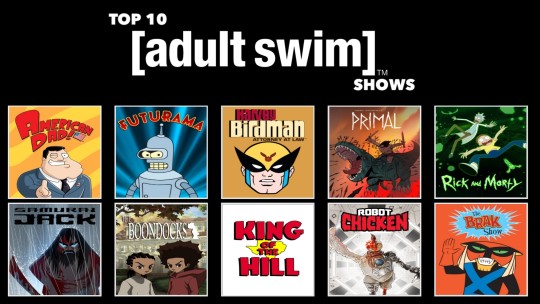
My Top 10 Adult Swim Shows
Attention Swimmers, Hm, Swimmers, Got Some Announcement To Tell You, Every Night On Cartoon Network, It's All Kids, Out of the pool, for Adult Swim, So, Here's My List Of Top 10 Shows On Adult Swim
#10 The Brak Show
#9 Robot Chicken
#8 King Of The Hill
#7 The Boondocks
#6 Samurai Jack
#5 Rick And Morty
#4 Genndy Tartakovsky's Primal
#3 Harvey Birdman: Attorney At Law
#2 Futurama
And #1 American Dad
Honorable Mentions: Aqua Teen Hunger Force, Family Guy, My Adventures with Superman, Metalocalypse, Unicorn: Warriors Eternal, Bob's Burgers, And Squidbillies
original template: https://www.deviantart.com/edogg8181804/art/Top-10-Adult-Swim-Shows-Meme-852140153
The Brak Show Belongs To Jim Fortier, Andy Merrill, Pete Smith, Hanna-Barbera Cartoons, Inc. Wild Hare Studios, Turner Entertainment Company, Williams Street Productions, LLC, Cartoon Network, Adult Swim, The Cartoon Network, Inc. Warner Bros. Discovery Networks, Warner Bros. Domestic Television Distribution Warner Bros. Television Studios, Warner Bros. Television Group, Warner Bros. Entertainment Inc. WarnerMedia And Warner Bros. Discovery, Inc.
Robot Chicken Belongs To Seth Green, Matthew Senreich, Mike Fasolo, ShadowMachine, Stoop!d Monkey, Stoopid Buddy Stoodios, LLC. Sony Pictures Digital Productions Inc. Sony Pictures Television Studios, Sony Pictures Television Inc. Sony Pictures Entertainment Inc. Sony Entertainment, Inc. Sony Corporation of America, Sony Group Corporation, Williams Street Productions, LLC, Cartoon Network, Adult Swim, The Cartoon Network, Inc. Warner Bros. Discovery Networks, Warner Bros. Domestic Television Distribution Warner Bros. Television Studios, Warner Bros. Television Group, Warner Bros. Entertainment Inc. WarnerMedia And Warner Bros. Discovery, Inc.
King of the Hill Belongs To Mike Judge, Greg Daniels, Plus One Entertainment Co., Ltd. Toon Boom Animation Inc. Rough Draft Korea Co, Ltd. Toonzone Entertainment, Wild Horse Animation Group, Y.R. Studio, Yeson Entertainment, Bandera Entertainment, Deedle-Dee Productions Judgemental Films, 3 Arts Entertainment, 20th Television Animation, 20th Television, Hulu, Disney Streaming, Disney Television Studios, Disney General Entertainment Content, Disney Entertainment, FOX Broadcasting Company, FOX Entertainment, FOX Corporation, And The Walt Disney Company
The Boondocks (2005 TV series) Belongs To Aaron McGruder, Madhouse, Inc. Lotto Animation, Inc. DongWoo Animation Co. Ltd. MOI Animation Co., Ltd. JM Animation Co., Ltd. Studio Mir Co., Ltd. Adelaide Productions, Rebel Base Productions, Sony Pictures Television Inc. Sony Pictures Entertainment Inc. Sony Entertainment, Inc. Sony Corporation of America, Sony Group Corporation, Cartoon Network, Adult Swim, The Cartoon Network, Inc. Warner Bros. Discovery Networks, Warner Bros. Domestic Television Distribution Warner Bros. Television Studios, Warner Bros. Television Group, Warner Bros. Entertainment Inc. WarnerMedia And Warner Bros. Discovery, Inc.
Samurai Jack Belongs To Genndy Tartakovsky, Digital eMation, Inc. Rough Draft Korea Co, Ltd. Cartoon Network Studios, Williams Street Productions, LLC, Cartoon Network, Adult Swim, The Cartoon Network, Inc. Warner Bros. Discovery Networks, Warner Bros. Domestic Television Distribution Warner Bros. Television Studios, Warner Bros. Television Group, Warner Bros. Entertainment Inc. WarnerMedia And Warner Bros. Discovery, Inc.
Rick And Morty Belongs To Justin Roiland, Dan Harmon, Justin Roiland's Solo Vanity Card Productions Harmonious Claptrap, Starburns Industries, Bardel Entertainment, Inc. Rick and Morty, LLC, Green Portal Productions, Williams Street Productions, LLC, Cartoon Network, Adult Swim, The Cartoon Network, Inc. Warner Bros. Discovery Networks, Warner Bros. Domestic Television Distribution Warner Bros. Television Studios, Warner Bros. Television Group, Warner Bros. Entertainment Inc. WarnerMedia And Warner Bros. Discovery, Inc.
Primal (TV series) Belongs To Genndy Tartakovsky, Studio La Cachette, Cartoon Network Studios, Williams Street Productions, LLC, Cartoon Network, Adult Swim, The Cartoon Network, Inc. Warner Bros. Discovery Networks, Warner Bros. Domestic Television Distribution Warner Bros. Television Studios, Warner Bros. Television Group, Warner Bros. Entertainment Inc. WarnerMedia And Warner Bros. Discovery, Inc.
Harvey Birdman: Attorney At Law Belongs To Michael Ouweleen, Erik Richter, Bardel Entertainment, Inc. Rough Draft Korea Co, Ltd. Hanna-Barbera Cartoons, Inc. J. J. Sedelmaier Productions, Inc. Turner Broadcasting System, Inc. Cartoon Network Studios, Williams Street Productions, LLC, Cartoon Network, Adult Swim, The Cartoon Network, Inc. Warner Bros. Discovery Networks, Warner Bros. Domestic Television Distribution Warner Bros. Television Studios, Warner Bros. Television Group, Warner Bros. Entertainment Inc. WarnerMedia And Warner Bros. Discovery, Inc.
Futurama Belongs To Matt Groening, David X. Cohen, Digital eMation, Inc. K Production Sdn. Bhd. Rough Draft Studios, Inc. Rough Draft Korea Co, Ltd. The Curiosity Company, The ULULU Company, 20th Television Animation, 20th Television, Hulu, Disney Streaming, Disney Television Studios, Disney General Entertainment Content, Disney Entertainment, FOX Broadcasting Company, FOX Entertainment, FOX Corporation, The Walt Disney Company, Comedy Central, Comedy Partners, MTV Entertainment Group, Paramount International Networks, Paramount Domestic Media Networks, Paramount Media Networks, Inc. And Paramount Global
American Dad! Belongs To Seth MacFarlane, Mike Barker, Matt Weitzman, Yearim Productions Co., Ltd. Underdog Productions, Fuzzy Door Productions, 20th Television Animation, 20th Television, Disney Television Studios, Disney General Entertainment Content, Disney Entertainment, FOX Broadcasting Company, FOX Entertainment, FOX Corporation, The Walt Disney Company, TBS, Warner Bros. Discovery Networks, Warner Bros. Entertainment Inc. WarnerMedia And Warner Bros. Discovery, Inc.
1 note
·
View note
Text
“In When the Bough Breaks Quanda Jarvis makes it into the beauty world and meets Daniel Warner, who becomes her attorney. The two are attracted to each other but will they become a couple?” – When the Bough Breaks by Ryanne Anthony
View On WordPress
0 notes
Text
4 (Possible) Reasons Johnny Depp Lost His Defamation Lawsuit Against the Sun

As we've said before, in the U.S. the defamatory statement had to cause you some type of harm in order for you to seek justice, however, in the U.K. the requirements are even more basic.
The statement in question must identify or refer to the claimant, neither of which happened in #AmberHeard's original op-ed- and although the op-ed was written and published in the United States, the Sun reported on it.
Further more, the Sun reported on an op-ed that did not explicity state Johnny Depp's name- HOWEVER, the op-ed was (and still is) of major public interest of millions around the globe.
Not only was the Sun not privy to the knowledge of (potential) defamation prior to commenting on it (making them unaware and in the clear accoridng to Reg. 19 of the 2002 EC Directive in the UK), BUT they also are protected under the UK defense of #reynoldsprivilege.
Lastly, careful research and responible behavior is rather subjective to the eye of the beholder so the decision to dispense the jury in favor of a judge made that subjective decision the monumental deciding factor and decreased Johnny's odds in having someone see his side.
This situation is the perfect example of why hiring an experienced and knowledgable #defamationlawyer is key.
A RM Warner #defamationattorney will make sure to fight for your right to a fair trial, regardless of the state or country you reside in, and will come prepared with the knowledge of that territory's laws so you're protected no matter the region.
We help clients all over the globe so click the link in the bio to schedule a consultation today!
#daniel r warner#daniel r warner attorney#daniel warner#daniel warner attorney#rmwarnerlaw#rm warner law#defamation#defamation lawsuit#defamationofcharacter#defamation johnny depp#justice for johnny#johnny depp vs amber heard#johnnydepp#depp vs heard
16 notes
·
View notes
Text
A Lawyer, a Father, a Friend: One Lawyer's Experiences with Depression & Recovery
A Lawyer, a Father, a Friend: One Lawyer’s Experiences with Depression & Recovery
This interview is part of the ongoing podcast series “True Stories,” where I have conversations with lawyers about their journeys through mental health challenges and well-being triumphs. In this podcast interview, I speak with Jim Warner about his struggles with major depression as a lawyer. Jim obtained his undergraduate degree at Harvard and his law degree from Boston College of Law in 1992.…

View On WordPress
#Attorneys#BigLaw#Boston College of Law#Dan Lukasik#Daniel T. Lukasik#depression management#depression recovery#Harvard#Jim Warner#Law firms#law school#law students#Lawyers#Legal profession#mental health#Mental Health podcast#mental well being#podcast#workplace mental health#Workplace Wellbeing
1 note
·
View note
Text
Masonry Monday: The Case of the Daring Decoy
An oil company president discovers that his secretary is secretly a spy for his rival. Shortly after, he’s seen at the scene of her murder by an eyewitness. But the spy had other secrets, and the eyewitness’s identification is based on one unusual feature.

Who’s Who
Perry Mason’s client: Daniel Conway, an oil company president on the verge of reelection when he catches a spy in his office
The victim: Rose Calvert, a recently promoted secretary who’s spying on Conway for her married boyfriend
Suspects: Warner Griffith, Conway’s main rival within the company, whose moll-turned-mole ends up dead in a hotel room Linda Griffith, Warner Griffith’s estranged wife, who knew the victim was his mistress and planned to destroy him with evidence Fred Calvert, the victim’s hapless husband, who kept hoping she’d return to him but can’t seem to accept her rejections Amelia Armitage, a mysterious benefactor of Conway’s who seems to know all about the stockholder trouble he’s facing Mavis Jordan, the hotel’s elevator operator, who’s very observant about the comings and goings, but only to a certain degree
The Setup
In the Cal-Texas Explorations office, president Daniel Conway lets himself into his office, where he discovers a woman rifling through his desk. Conway is suspicious of the woman, Rose Calvert, and asks whether she’s spying on him on behalf of Warner Griffith. Rose denies knowing him, but Conway’s secretary, Miss Eastman, agrees that the recently promoted Rose will return to her previous position in accounting. Later, Rose excitedly phones Griffith and says she’s got the papers he wanted: A confidential report.

Later that night, a woman with glasses lets herself into the Cal-Texas offices. Conway says into his dictaphone that he’s checked his desk and he’s sure Rose has stolen his confidential documents, then spots the woman. She identifies herself as Amelia Armitage, and says she must speak to him urgently. She says she knows he’s in a battle with Griffith to control Cal-Texas, and she doesn’t trust Griffith to protect the shareholders. She advises Conway to make nice with the shareholders to get re-elected. He watches her stride out, looking besotted.
Sometime later, yet another woman calls the Cal-Texas office from a payphone. Conway answers, and the woman says she has information for his re-election: A list of Griffith’s proxies and his partnered shareholders. She won’t give her name, as she believes his phone is tapped, and he’s being followed. The woman tells him to go to a certain drug store and answer one of the public phones when it rings at 8:15. She’ll give him directions from there. At 8:10, he goes to the assigned booth, which rings early. The woman’s voice on the other end says to meet her at Hotel Red Fern, Room 709, immediately. He leaves, and a woman exits another booth shortly after.
Conway goes to the Red Fern and enters the elevator. The operator doesn’t look up from her book, but takes him up to the seventh floor. He goes to room 709 and rings the bell. No one answers, but it’s unlocked. The room has been tossed, and no one responds to his call. But he finds the body of Rose Calvert. A revolver is next to her. He bends down, placing his hand on a nearby chair. He picks the gun up, tucks it in his coat, and wipes down almost every surface he touched with a handkerchief. He leaves, walks down to the sixth floor, and reenters the elevator. The operator, without looking up, comments on his walking down a flight. Downstairs, Tragg and a sergeant enter the hotel and pass Conway heading out.
Enter Perry Mason, Attorney at Law
Conway and his company’s council, Mr. Varnell, are sitting in Perry Mason’s office. Varnell was the only lawyer Conway could consult, and he found the lawyer at the Bar Association dinner, where he was sharing a table with Mason. Perry inspects the gun and notes the serial number, telling Conway he shouldn’t have removed it. Conway says he panicked when he recognized it was a company gun. Perry asks if there’s any proof of the phone calls, and Conway says no.

Suddenly Conway places where he’d heard the woman’s voice before. It was Warner Griffith’s wife, Linda. Perry tells Della to have Paul locate Griffith and turn the gun over to the police. He tells Conway to stay out of sight at the hotel, but to register under his own name. Varnell says this may jeopardize Conway’s bid for company re-election, but Perry impresses upon him that this is more important. In the meantime, he’s going to go visit Mrs. Griffith.
At Linda Griffith’s apartment, Perry asks about her calling Conway and leading him into a trap. She slips and admits she did call him (though she says she’ll deny it), but only the first time -- she didn’t call him at the drugstore because he wasn’t there at 8:15 to take the second call. She didn’t send him to the hotel room and wasn’t aware of the murder. It could have been an imposter who called him -- she suspected his phone was tapped. She says she’s trying to undermine her husband for their divorce.
Linda shows Perry a risque photo of Rose Calvert in skimpy clothes, which she discovered on a roll of film in her husband’s camera. She tells him Rose did part-time work for Griffith as part of his proxy business to take control of Cal-Texas. She also gives Perry Rose’s address and says she was married but separated. She also reneges on her promise to give Conway her proxies, as she can’t afford to tip her hand with her husband now that they’re involved in a murder. Perry leaves, taking the photo of Rose with him.
Perry visits Rose’s apartment building, but doesn’t enter, instead looking at a letter poking out of her mailbox. It’s a letter from Fred Calvert, who lives in a house in Ellendale. He goes to the house, despite the late hour, and meets Calvert. The man admits to being Rose’s husband, and, thinking Perry’s here on her behalf, insists he won’t give her a divorce. He says he knows she needs to sew her wild oats, but he can offer her security with his mortgage-free house. Perry breaks the news that Rose may have been murdered and shows him the picture. Calvert rambles about the house, distraught, and Perry leaves.

The Murder
Still in the late hours, Perry returns to the office, and Della says there’s trouble -- Tragg has put an APB out for Conway’s arrest. Burger wants to know where Paul got the gun, and the detective himself is in the office with one Warner Griffith. Perry tells Della to go home and get some sleep. In the office, Paul introduces Perry to Mr. Griffith. Perry immediately confronts Griffith with the morning edition of the paper, which reported the murder. He says Griffith must have recognized Rose, but Griffith says he came to Perry’s office as soon as Paul summoned him.
Griffith agrees that he knew Rose. Perry immediately proposes his theory that Griffith is the murderer: He was having an affair with Rose, who was also his contact at Cal-Texas. His wife discovered the affair and threatened divorce. This would make Rose a liability in both his divorce and his business dealings. Griffith coolly says that, at the time of the murder, he was in Phoenix. He produces his plane reservations proving he didn’t return to LA until 1 am, only a few hours previously.
In Burger’s office, Tragg has brought Mason to answer questions. Burger asks where Daniel Conway is, and Mason says he doesn’t know, as they haven’t spoken yet that day. He also refuses to say where he got the gun by virtue of attorney-client privilege. Burger says it’s the murder weapon. He also accuses Mason of withholding the identity of the victim, but Mason says he wasn’t sure at the time, and couldn’t speculate about it. Burger reveals they followed Mason’s line of reasoning about having Conway stay in a hotel under his own name -- Tragg opens the office door to reveal Conway in custody.
In Perry’s office, Paul says he can’t find the mystery woman who came into the office, but Perry says her being there was no coincidence -- she had no way to know Conway was there, for starters. Della buzzes through to say the woman herself, Amelia Armitage, is in the office. Amelia enters and says she’s hoping for the best for Conway. Perry asks when she visited Conway’s office: She says 7pm. She also says she overheard the phone call telling Conway to visit the drugstore and followed him there out of curiosity, also seeing him enter the phone booth at 8:10.

Perry asks if she’d be willing to tell that story in court. Amelia says yes, adding she’s already told Burger, who told her to come to Perry. He immediately calls her bluff, saying she must have read about the calls in the paper as the details aren’t lining up. She admits it, and apologizes, but says she feels Conway is innocent. She shamefacedly shows herself out. Perry tells Paul that Burger wouldn’t have believed her story either, and tells him to check out Amelia.
The Trial
Burger gives his opening statement to the jury. The first witness we see is Fred Calvert, who testifies that he identified his wife’s body. He first learned of Rose’s death from his late-night visitor, who showed him a picture of her. Mason stipulates in lieu of cross that he was the visitor. Next on the stand is Tragg, who testifies they discovered the hotel at 8:40 that evening, acting on an anonymous tip. They found only one set of prints in the room: The ones Conway forgot to wipe off of the chair next to the body. Tragg also testifies that the police received a parcel containing the murder weapon.
As the jury examines the gun, Tragg testifies that he received identification of the body from Calvert, not from Mason. Mason objects, and the judge restrains Burger, saying Mason potentially withholding evidence is a matter for another courtroom. On cross, Mason offers to clarify the topic of his alleged misconduct. He asks Tragg to clarify that Calvert said Mason identified Rose -- he didn’t. Mason says the he suspected it was Rose, and so directed her husband to go to the morgue and identify her. Tragg is forced to admit that Mason did what any conscientious citizen would have done.
The next witness is Mavis Jordan, the elevator operator. She testifies she let Conway off at the 7th floor while reading a book at around 8:30. On cross, Mason asks her the title of her book: It was You Could Die Laughing. She found it quite engrossing -- so much so that Mason believes she couldn’t have looked at Conway’s face. On redirect, Burger asks Mavis to clarify how she recognized Conway: By his feet. She mostly sees shoes and feet, so she can pick them out more easily than faces. But it was easy with Conway -- when he descended, he entered on the sixth floor, so she knew he walked down a flight.

The next witness is Warner Griffith, whose is suddenly very cozy with his wife. Griffith testifies he was on the board of directors of Cal-Texas until four months previously, when he resigned over a dispute with Conway. He adds that he employed Rose for covert work -- gathering the proxies, yes, but more importantly to collect information for a white paper about Conway. Mason objects, but the judge says it goes to motivation. Griffith says the white paper concerned Conway allegedly turning info to competitors about oil leases. She kept it in her hotel room.
Burger infers that someone looking for the white paper would have to tear about the hotel room. Mason objects to the line of questioning, saying Burger is leading the witness. The judge agrees, but Burger continues to say that the white paper was only a threat to Conway, and Conway had to know she’d stolen it from his desk. Griffith agrees, saying it’s why Conway killed her. The jury erupts into murmurs at that remark.
The Investigation
Sometime later, Perry arrives at Mrs. Griffith’s apartment with Mavis in tow. To Linda’s consternation, Mavis goes rifling through her shoe closet and finds the shoes she was wearing on the night of the murder. Mavis says she dropped Linda off on the 7th floor, and compliments Mrs. Griffith’s step. Linda tries to deny it, but Perry accurately assesses that she was the one who searched the hotel room. Linda breaks, admitting she wanted to confront Rose about her affair, but found her already dead.
She thought her husband did it, and admitted at that moment she stopped hating him and wanted to protect him. She tossed the room looking for any evidence he’d been there, wiped it of prints, called Conway both times to lead him to the body, then tipped off the police so they’d discover him in the hotel room. Linda frantically denies it could have been Griffith, as he was in Phoenix when Rose was killed. Perry agrees that that’s what Griffith claims. He leaves with Mavis as Linda sobs.

Back in court, Paul gives Mason evidence that Griffith was definitely in Phoenix -- however, no one can account for him between 6-11 on the night of the murder. The trial resumes, and Mason cross-examines Warner Griffith. He asks about the details of the white paper: Specifically, he asks whether Conway’s info-brokering with competitors involved buying opportunities for Cal-Texas, which would have been above-board. Griffith claims to have not thought of it, but Mason claims he should have if he wanted to be President of Cal-Texas.
He also points out that a smear campaign of Conway, while it may bolster Griffith’s fortunes, is draining the shareholders, as the stock has depreciated and they’re losing out on dividends. Griffith tries to argue with the judge about how the questions are unfair, but the judge rightfully points out that Griffith himself brought it up. Mason points out that, if the white paper was about aboveboard business practices, it would furnish no motive for murder, and Griffith has no response.
Next, Mason asks if Griffith saw the murder weapon in the possession of Rose Calvert: He did. Mason next pokes a hole in Griffith’s alibi in Phoenix, as he had time during the missing hours to charter a plane to fly to Los Angeles. Griffith says he never went to the hotel -- he visited her actual apartment, but she wasn’t there. Mason decides to recall a witness who can prove that at least one of the suspects in this case has a motive for murder, and they’re lying . . .
In Summation
We get one of our first cases of corporate espionage with this mystery. Granted, it’s a bit hard to follow if you’re not familiar with a lot of the terminology they use, but the central thread of the mystery is easy enough to get: A girl in Conway’s office took something she shouldn’t have, and now Conway’s accused of killing her to get it back. Easy enough. And I won’t spoil, but one thing I like about this particular mystery is that the motive of the actual killer turns out to be just as simple and easy to comprehend.

Before I get to the story, I want to praise the cinematography of this episode in particular. I’m not sure what the impetus was, but this episode has so much more of a noir vibe compared with previous episodes, with some well-composed wide shots and moody lighting during the nighttime scenes. I appreciate the episodes that harken to Perry Mason’s noir mystery roots, and any episode that shows dusk scenes where Mason is slinking around outside apartment buildings in a trenchcoat really hit a good note for me.
The victim in this case has so much going on behind the scenes that I would have liked to see more than five seconds of her onscreen. She’s a wayward wife with a long-suffering husband back at home, and the mistress of the executive looking to take over an oil company who’s secretly doing some spying for him on the side and managed to make off with sensitive documents. That’s a lot -- I’m not sure how she had time to eat. Yet the few moments she’s onscreen, she’s immediately caught in her snooping, made for a spy, and sent packing. Again, I wish we saw more of her actually being competent.
Speaking of incompetence, what the heck is with the women of this episode and their cloak-and-dagger scheming? First Amelia Armitage walks into Conway’s office past business hours and tells him in the most roundabout way to get his house in order (not telling him who she is, either). Then Linda Griffith makes two anonymous phone calls to supposedly help him in his recruitment of shareholders. Both have ulterior motives, it’s true, but poor Conway must have been so confused with all these people not giving him a straight answer.
Not to sound like I don’t sympathize with the character type, but most of the defendants so far this season have been abused or imposed-upon women, wives and daughters. I applaud Perry Mason for taking on such clients regularly, but it does tend to make these episodes bleed together. Daniel Conway is notable simply by not being that type of character, though he does share the unfortunate Mason client tendency of doing something stupid to try and beat a police investigation -- in this case, haphazardly wiping his prints (and missing some) and walking down a flight of steps.

Still, it’s hardly Conway’s fault that the Hotel Red Fern has an elevator operator -- those are relative rarity in this show, if not for the time period -- and one who’s selectively oblivious in the most unpredictable way. Few side characters in Perry Mason are as much of a kooky delight as Mavis Jordan the elevator operator. She apparently distracts herself from her rather humdrum job by reading and studying people’s shoes and feet. The episode treats it as slightly laughable, but I’d like to remind everyone that stride length was valuable knowledge to Sherlock Holmes.
Piece of trivia here: The book she says she was reading in the elevator, You Can Die Laughing, is actually another book by Erle Stanley Gardner. It’s in his Cool & Lam detective novel series, slightly lesser-known than his Perry Mason novels, which he wrote under the pseudonym A.A. Fair. The episode phrases the title as if it’s a joke, but the book is actually a serious mystery, so I can see why Mavis was so engrossed.
If the women in this case are somewhat overthinkers and go a little heavy on the subterfuge, it’s just to make up for what wet blankets the men are (Conway, to a certain extent, included). Warner Griffith makes a very bad impression as a man who’s trying to take over a business he doesn’t full understand, and Fred Calvert can’t do anything but bleat about his mortgage-free house, both when he’s just been informed that his wife is dead and when he’s testifying against her alleged murderer at trial. They’re not bad characters -- quite the opposite. It makes it hard to peg what the real motive is underneath the artifice.
This is also one of those cases where we get to see Burger and Mason get into a professional tussle. While the two of them may respect each other, Burger never fails to let Perry know that he doesn’t approve of his methods or (what he sees) as his cavalier attitude towards the rule of law. He does manage to get one over on Perry, however briefly -- he knows Perry well enough to know how he’d “hide” his client in plain sight, and thus he and Tragg manage to track Conway despite Mason’s best efforts. Burger may sometimes jump to erroneous conclusions, but as a DA he’s got his head on straight.

The Verdict
Judgement: ⚖⚖⚖ (three scales out of four) This is what good Perry Mason episodes are made of: A strong central hook with a myriad of likely suspects. I wish we got more time with the victim, but the web of intrigue around her makes for a good plot, despite the client being as dumb as any other. This episode even cracks a few jokes -- a rarity for the series.
#perry mason#masonry monday#paramount plus#raymond burr#s01e28#della street#paul drake#the case of the daring decoy
2 notes
·
View notes
Text
Pioneering Black Actors of Hollywood By Susan King
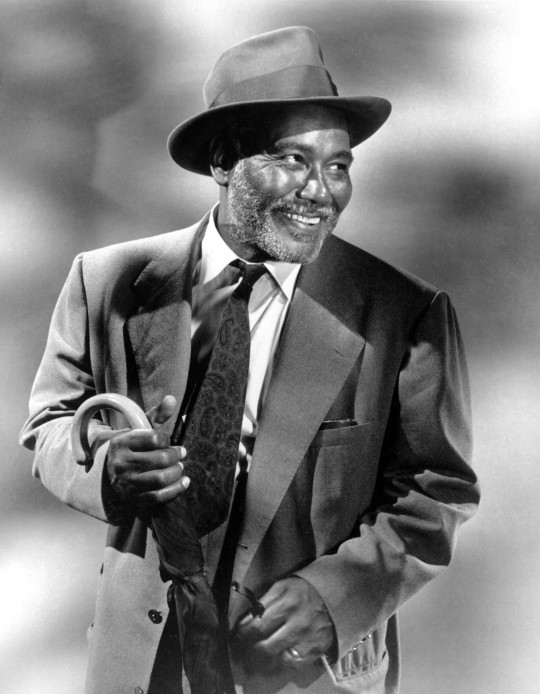
Clarence Muse and Rex Ingram by Susan King Thirty years ago, the legendary Oscar-winning actor Sidney Poitier reflected on the Black performers who paved the way for him in the Los Angeles Times: “The guys who were forerunners to me, like Canada Lee, Rex Ingram, Clarence Muse and women like Hattie McDaniel, Louise Beavers and Juanita Moore, they were terribly boxed in. They were maids and stable people and butlers, principally. But they, in some way, prepared the ground for me.”
Poitier prepared the ground for such contemporary Black actors and directors currently in competition during the 2021 awards season such as Regina King and Leslie Odom Jr. (One Night in Miami), Delroy Lindo (Da 5 Bloods), the late Chadwick Boseman and Viola Davis (Ma Rainey’s Black Bottom), Andra Day (The United States vs. Billie Holiday) and Daniel Kaluuya (Judas and the Black Messiah).
But it is imperative to remember the veterans from the 1930s-1960s who tried to break out of stereotypes and maintain dignity at a time when Hollywood wanted to “box” them in.
Clarence Muse
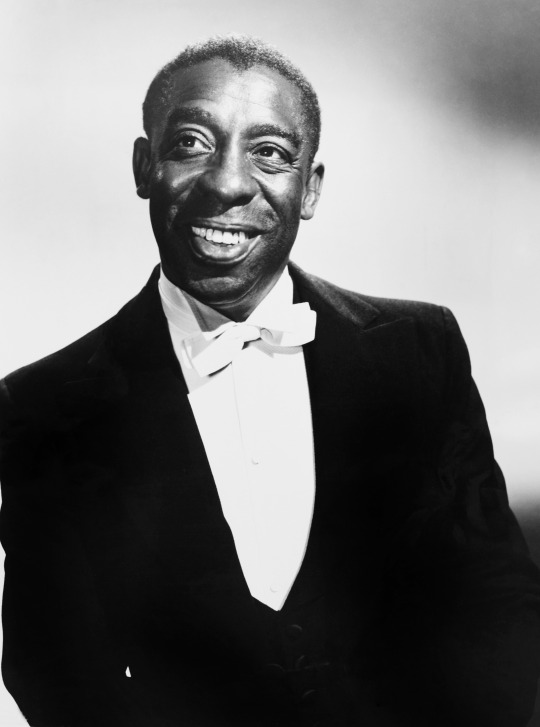
Muse appeared in countless Hollywood films often uncredited. And as Donald Bogle points out in his book Hollywood Black, Muse spoke his mind to directors if he felt he was being pushed around or when his characters were stereotypes. Bogle stated, “At another time when Muse questioned the actions of his character in director King Vidor’s 1935 Old South feature SO RED THE ROSE, Vidor recalled that Muse was quite vocal in expressing his concerns. A change was made. Vidor could not recall exactly what the issue was, but he never forgot Muse’s objection.”
The 1932 pre-Code crime drama Night World screened at the 2019 TCM Classic Film Festival to a standing-room only crowd. The film stars Lew Ayres, Boris Karloff and Muse as the doorman at a club owned by Karloff. The audience was surprised that such a stereotypical role was anything but thanks to Muse’s poignant performance. Instead of being forced to be the comic relief, Muse’s Washington is a man worried about his wife’s surgery at a local hospital. Though his boss doesn’t treat him as an equal—after all it is 1932—Karloff’s Happy shows general concern toward Washington.
Muse, said Bogle, “also worked in race movies, where he realized there was still a real chance for significant roles and narratives.” One such was BROKEN STRINGS (’40), which he also co-wrote. It’s certainly not a great film, but Muse gives a solid turn as a famed Black violinist who wants his young son to follow in his footsteps. But the son wants to play swing with his violin.
Muse, who was a graduate of Dickinson College in Pennsylvania, also co-wrote the Louis Armstrong standard “Sleepy Time Down South.” In the 1920s, he worked at two Harlem theater companies, Lincoln Players and Lafayette Players, and 23 years later he became the first African American Broadway director with Run Little Chillun. He continued to act, appearing in Poitier’s directorial debut BUCK AND THE PREACHER (’72), CAR WASH (’76) and THE BLACK STALLION (’79) and was elected to the Black Filmmakers Hall of Fame in 1973. He died one day before his 90th birthday in 1979.
Rex Ingram

Tall and imposing, Ingram had a great presence on the big screen and a rich melliferous voice. No wonder his best-known role was as the gigantic Genie in the bottle in Alexander Korda’s lavish production of THE THIEF OF BAGDAD (’40). Born in 1895, he began his film career in movies such as Cecil B. DeMille’s THE TEN COMMANDMENTS (’23). Ingram also has the distinction of playing God in THE GREEN PASTURES (’36) and Lucifer Jr. both on Broadway in 1940 and in the 1943 film adaptation of the musical CABIN IN THE SKY.
Ingram also brought a real humanity to his role as the slave Jim in MGM’s disappointing THE ADVENTURES OF HUCKLEBERRY FINN (’39), starring a miscast Mickey Rooney, who was way too old at 19 to play the part. Ingram, though, breaks your heart when he talks to Huck about how his dream is to earn enough money to buy his freedom so he could join his wife and child living in a free state. And when he runs away, Ingram explains to Huck why he had to flee the widow Douglas: “If one of them slave traders got me, I never would get to that free state. I would never see my wife, or little Joey.”
He also is superb in Frank Borzage’s noir MOONRISE (’48) as Mose Johnson, the friend of the murderer’s son Danny (Dane Clark), who lives in a shack in the wilderness with his coonhounds. Noble and thoughtful, Mose is the film’s conscience and helps guide Danny to do the right thing after he kills a bully (Lloyd Bridges) in self-defense.
Ingram was one of the busiest Black actors at the time and at one point even served on the Board of the Screen Actors Guild. But the same year MOONRISE was released, he was arrested and pleaded guilty for transporting an underage girl from Kansas to New York. He served a prison sentence and for a long time his career was derailed. He even lost his home. Though his film career was never the same upon his release, he worked in TV and on the Broadway stage, appearing in Beckett’s Waiting for Godot, and died in 1969 at 73 shortly after doing a guest shot on NBC’s The Bill Cosby Show.
Ernest Anderson

Anderson never achieved the notoriety of Muse and Ingram, but the actor gave an extraordinary performance in the Bette Davis-Olivia de Havilland melodrama IN THIS OUR LIFE (’42) directed by John Huston. Born in 1915, Anderson earned his BA at Northwestern University in drama and speech. He was recommended for his role in the movie by Davis, who saw the young man working at the commissary on the Warner Bros.’ lot.
Anderson plays Parry, the son of the Davis-de Havilland family’s maid who aspires to be a lawyer. Davis’ spoiled rotten Stanley Timberlake gets drunk, and while driving she kills someone in a hit-and-run accident. Stanley throws Parry under the bus telling authorities he was the one driving the car.
Initially, the script depicted Parry in much more stereotypical terms, but Anderson went to Huston and discussed why he wanted to play the character with dignity and intelligence. Huston agreed. And for 1942, it’s rather shocking to see a studio film look at racism as in the scene where Parry tells de Havilland’s Roy why he wants to be an attorney:
“Well, you see, it’s like this, Miss Roy: a white boy, he can take most any kind of job and improve himself. Well, like in this store! Maybe he can get to be a clerk or a manager. But a colored boy, he can’t do that. He can keep a job, or he can lose a job. But he can’t get any higher up. So, he’s got a figure out something he can do that no one can take away. And that’s why I want to be a lawyer.”
Needless to say, such monologues were cut when the movie was shown in the South. Despite strong reviews for his performance, Anderson never got another role with so much substance. But he continued working through the 1970s and died in 2011 at the age of 95.
#Clarence Muse#Rex Ingram#Ernest Anderson#Bette Davis#Warner Bros#Black actors#Hollywood Black#TCM#Turner Classic Movies#black representation#Susan King
155 notes
·
View notes
Text
Batman 89: Billy Dee Williams Finally Becomes Two-Face in Burtonverse Comic
https://ift.tt/eA8V8J
The Batman Burtonverse is coming back in a big way. Not only is Warner Bros. bringing back Michael Keaton as Batman in the upcoming Flash movie but DC Comics is set to publish a 6-issue limited series that explores what happened next after Tim Burton’s first Gotham City outing rolled credits.
Batman ’89 brings together the movie’s original screenwriter, Sam Hamm, with artist Joe Quinones, who has been tied to a revival of the Burtonverse in the comics for quite some time. Quinones previously pitched a similar miniseries to DC, at the time to be written by Kate Leth (Hellcat). While the idea was rejected, Quinones’ designs for a comic book sequel to Batman have received tons of praise from fans in the years since. It’s no surprise, then, that the idea stuck at DC, and that we’ll finally get to see Quinones’ take on the Burtonverse.
Hamm’s return to the Burtonverse is also notable. After the massive blockbuster success of Batman, Burton, Keaton, and Hamm were quickly tapped to make a sequel, with Hamm taking a first stab at the script, which would have introduced Robin as well as shown District Attorney Harvey Dent’s transformation into Two-Face. You probably know what happened next: Burton was unhappy with Hamm’s script (the director detests the Boy Wonder, for one thing) and said he would not direct the picture unless he could make a “Tim Burton movie,” not a Batman sequel, according to Hamm. The rest is history: Heathers screenwriter Daniel Waters replaced Hamm and the result was Batman Returns.
Since Batman ’89 will “pull on a number of threads left dangling by the prolific director,” the series is an opportunity for Hamm to finally deliver his vision for “Batman II.” As you’d expect, one of the storylines from his unused script that will be front and center in the miniseries is Harvey’s villainous turn, which means we’ll finally get to see Billy Dee Williams’ version of the character become Two-Face within the Burtonverse.
In fact, a variant cover drawn by the legendary Jerry Ordway, who drew the beloved comic book adaptation of Burton’s movie, gives us our first official look at William’s Dent as the villain he was destined to become:
First revealed by excellent comic book site 13th Dimension, the cover features Williams’ Two-Face looming over the Dark Knight, who’s swinging across the streets of Gotham wearing what looks like (at least in the bright lights of the city) a comics-accurate blue-ish cape and cowl. It’s a nice reimagining of what Keaton would have looked like if he’d donned the blue and gray of his comic book counterparts back in 1989 as opposed to the all-black suit that’s become the standard look of all movie Batmen since.
Back in 2016, Quinones also shared a sketch of what his Two-Face would look like, and we can only hope this design, which fuses the real-life actor with the comic book character perfectly, made it into the final version of the book:
Although he never got to play Two-Face in the Burton movies, Williams did eventually voice the character in The Lego Batman Movie, but that’s not really a continuation of his work in Batman, just a fun cameo. The new comic is the real deal for Williams’ Two-Face.
While Batman ’89 will be available digitally first on July 27, the series will hit stands as a physical book on Aug. 10. You can check out the full solicitation for the first issue below:
BATMAN ’89 #1 Story by SAM HAMM Pencils by JOE QUINONES Inks by JOE QUINONES Cover by JOE QUINONES ON SALE 8/10/21 Price: US $3.99 | 32 pages | FC | DC CARD STOCK OPEN ORDER Variant by JERRY ORDWAY. Price: US $4.99 1:25 Design Variant by JOE QUINONES. Price: US $4.99 TEAM VARIANT by KEN TAYLOR/TAURIN CLARKE. Price: US $4.99
Step back into the Gotham of Tim Burton’s seminal classic Batman movies! Batman ’89 brings in screenwriter Sam Hamm (Batman, Batman Returns) and artist Joe Quinones (Dial H for Hero) to pull on a number of threads left dangling by the prolific director. Gotham becomes torn in two as citizens dressed as Batman and The Joker duke it out in the streets. As D.A. Harvey Dent tries to keep the city together, he targets the one problem tearing it apart: BATMAN! And he’ll get Bruce Wayne’s help in taking down the Dark Knight!
cnx.cmd.push(function() { cnx({ playerId: "106e33c0-3911-473c-b599-b1426db57530", }).render("0270c398a82f44f49c23c16122516796"); });
The post Batman 89: Billy Dee Williams Finally Becomes Two-Face in Burtonverse Comic appeared first on Den of Geek.
from Den of Geek https://ift.tt/3bYNCMG
2 notes
·
View notes
Text
The True History Behind 'Judas and the Black Messiah'
https://sciencespies.com/history/the-true-history-behind-judas-and-the-black-messiah/
The True History Behind 'Judas and the Black Messiah'
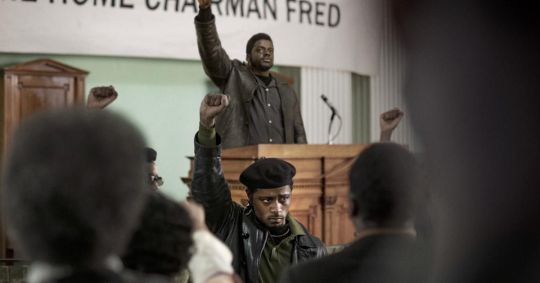
SMITHSONIANMAG.COM | Feb. 11, 2021, 3:15 p.m.
When Chicago lawyer Jeffrey Haas first met Fred Hampton, chairman of the Illinois chapter of the Black Panther Party, he was struck by the 20-year-old activist’s “tremendous amount of energy” and charisma. It was August 1969, and Haas, 26 years old at the time, and his fellow attorneys at the People’s Law Office had just secured Hampton’s release from prison on trumped-up charges of stealing $71 worth of ice cream bars. To mark the occasion, Hampton delivered a speech at a local church, calling on the crowd to raise their right hand and repeat his words: “I am a revolutionary.”
“I couldn’t quite say that, because I thought I was a lawyer for the movement, but not necessarily of the movement,” recalls Haas, who is white. “But as Fred continued saying that, by the third or fourth time, I was shouting ‘I am a revolutionary’ like everyone else.”
youtube
Judas and the Black Messiah, a new film directed by Shaka King and co-produced by Black Panther director Ryan Coogler, deftly dramatizes this moment, capturing both Hampton’s oratorical prowess and the mounting injustices that led him and his audience to declare themselves revolutionaries. Starring Daniel Kaluuya of Get Out fame as the chairman, the movie chronicles the months preceding Hampton’s assassination in a December 1969 police raid, detailing his contributions to the Chicago community and dedication to the fight for social justice. Central to the narrative is the activist’s relationship with—and subsequent betrayal by—FBI informant William O’Neal (LaKeith Stanfield), who is cast as the Judas to Hampton’s “black messiah.”
“The Black Panthers are the single greatest threat to our national security,” says a fictionalized J. Edgar Hoover (Martin Sheen), echoing an actual assertion made by the FBI director, in the film. “Our counterintelligence program must prevent the rise of a black messiah.”
Here’s what you need to know to separate fact from fiction ahead of Judas and the Black Messiah’s debut in theaters and on HBO Max this Friday, February 12.
Is Judas and the Black Messiah based on a true story?
In short: yes, but with extensive dramatic license, particularly regarding O’Neal. As King tells the Atlantic, he worked with screenwriter Will Berson and comedians Kenny and Keith Lucas to pen a biopic of Hampton in the guise of a psychological thriller. Rather than focusing solely on the chairman, they opted to examine O’Neal—an enigmatic figure who rarely discussed his time as an informant—and his role in the FBI’s broader counterintelligence program, COINTELPRO.
“Fred Hampton came into this world fully realized. He knew what he was doing at a very young age,” says King. “Whereas William O’Neal is in a conflict; he’s confused. And that’s always going to make for a more interesting protagonist.”
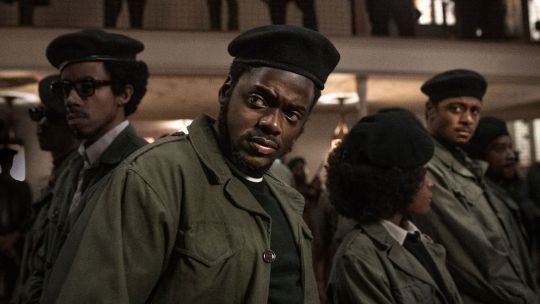
Daniel Kaluuya (center) as Fred Hampton
(Glen Wilson / Warner Bros.)
Speaking with Deadline, the filmmaker adds that the crew wanted to move beyond Hampton’s politics into his personal life, including his romance with fellow activist Deborah Johnson (Dominique Fishback), who now goes by the name Akua Njeri.
“[A] lot of times when we think about these freedom fighters and revolutionaries, we don’t think about them having families … and plans for the future—it was really important to focus on that on the Fred side of things,” King tells Deadline. “On the side of O’Neal, [we wanted] to humanize him as well so that viewers of the film could leave the movie wondering, ‘Is there any of that in me?’”
Who are the film’s two central figures?
Born in a suburb of Chicago in 1948, Hampton demonstrated an appetite for activism at an early age. As Haas, who interviewed members of the Hampton family while researching his book, The Assassination of Fred Hampton: How the FBI and the Chicago Police Murdered a Black Panther, explains, “Fred just couldn’t accept injustice anywhere.” At 10 years old, he started hosting weekend breakfasts for other children from the neighborhood, cooking the meals himself in what Haas describes as a precursor to the Panthers’ free breakfast program. And in high school, he led walkouts protesting the exclusion of black students from the race for homecoming queen and calling on officials to hire more black teachers and administrators.
According to William Pretzer, a supervisory curator at the Smithsonian’s National Museum of African American History and Culture (NMAAHC), the young Hampton was keenly aware of racial injustice in his community. His mother babysat for Emmett Till prior to the 14-year-old’s murder in Mississippi in 1955; ten years after Till’s death, he witnessed white mobs attacking Martin Luther King Jr.’s Chicago crusade firsthand.
“Hampton is really influenced by the desire of the NAACP and King to make change, and the kind of resistance that they encounter,” says Pretzer. “So it’s as early as 1966 that Hampton starts to gravitate toward Malcolm X … [and his] philosophy of self-defense rather than nonviolent direct action.”
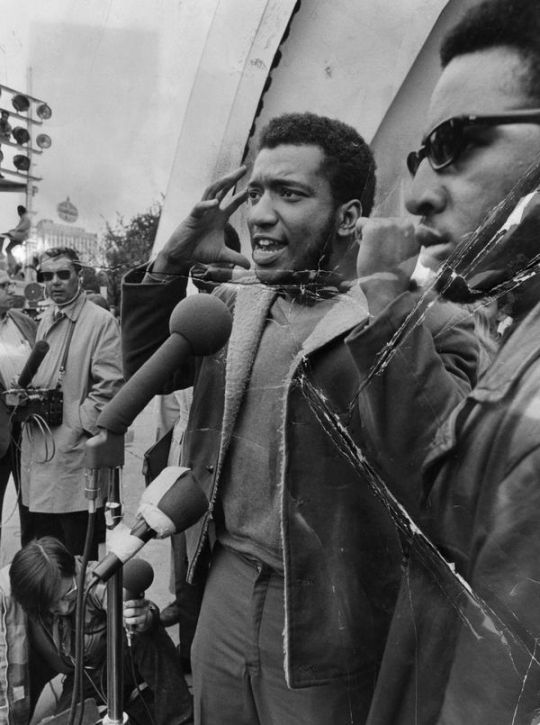
Fred Hampton speaks at a rally in Chicago’s Grant Park in September 1969
(Chicago Tribune file photo / Tribune News Service via Getty Images)

William O’Neal in a 1973 mugshot
(Fair use via Wikimedia Commons)
After graduating from high school in 1966, Hampton, as president of the local NAACP Youth Chapter, advocated for the establishment of an integrated community pool and recruited upward of 500 new members. In large part due to his proven track record of successful activism, leaders of the burgeoning Black Panther Party recruited Hampton to help launch the movement in Chicago in November 1968. By the time of his death just over a year later, he’d risen to the rank of Illinois chapter chairman and national deputy chairman.
O’Neal, on the other hand, was a habitual criminal with little interest in activism before he infiltrated the Panthers at the behest of FBI agent Roy Mitchell (portrayed in the film by Jesse Plemons). As O’Neal recalled in a 1989 interview, Mitchell offered to overlook the-then teenager’s involvement in a multi-state car theft in exchange for intel on Hampton.
“[A] fast-talking, conniving West Side black kid who thought he knew all the angles,” O’Neal, according to the Chicago Tribune, joined the party and quickly won members’ admiration with his bravado, mechanical and carpentry skills, and willingness to place himself in the thick of the action. By the time of the police raid that killed Hampton, he’d been appointed the Panthers’ chief of security.
“Unlike what we might think of an informer being a quiet person who would appear to be a listener, O’Neal was out there all the time spouting stuff,” says Haas. “People were impressed by that. … He was a ‘go do it’ guy. ‘I can fix this. I can get you money. I can do these kinds of things. And … that had an appeal for a while.”
Why did the FBI target Hampton?
Toward the beginning of Judas and the Black Messiah, Hoover identifies Hampton as a leader “with the potential to unite the Communist, the anti-war, and the New Left movements.” Later, the FBI director tells Mitchell that the black power movement’s success will translate to the loss of “[o]ur entire way of life. Rape, pillage, conquer, do you follow me?”
Once O’Neal is truly embedded within the Panthers, he discovers that the activists are not, in fact, “terrorists.” Instead, the informer finds himself dropped in the midst of a revolution that, in the words of co-founder Bobby Seale, was dedicated to “trying to make change in day-to-day lives” while simultaneously advocating for sweeping legislation aimed at achieving equality.
The Panthers’ ten-point program, penned by Seale and Huey P. Newton in 1966, outlined goals that resonate deeply today (“We want an immediate end to POLICE BRUTALITY and MURDER of Black people”) and others that were certain to court controversy (“We want all Black men to be exempt from military service” and “We want freedom for all Black men held in federal, state, county and city prisons and jails”). As Jeff Greenwald wrote for Smithsonian magazine in 2016, members “didn’t limit themselves to talk.” Taking advantage of California’s open-carry laws, for instance, beret-wearing Panthers responded to the killings of unarmed black Americans by patrolling the streets with rifles—an image that quickly attracted the condemnation of both the FBI and upper-class white Americans.
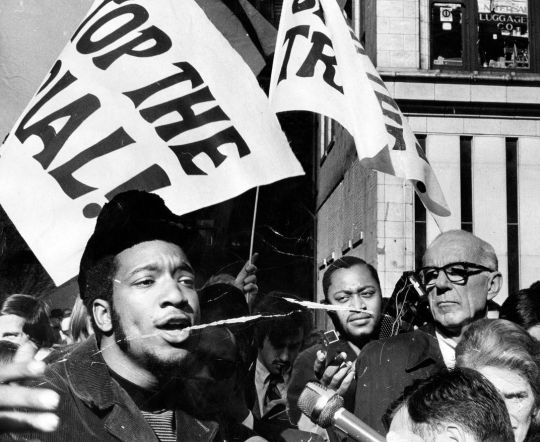
Fred Hampton (far left) attends an October 1969 rally against the trial of eight people accused of conspiracy to start a riot at the Democratic National Convention.
(Don Casper / Chicago Tribune / Tribune News Service via Getty Images)
According to Pretzer, law enforcement viewed the Panthers and similar groups as a threat to the status quo. “They are focused on police harassment, … challenging the authority figures,” he says, “focusing on social activities that everybody thinks the government should be doing something about” but isn’t, like providing health care and ensuring impoverished Americans had enough to eat.
The FBI established COINTELPRO—short for counterintelligence program—in 1956 to investigate, infiltrate and discredit dissident groups ranging from the Communist Party of the United States to the Ku Klux Klan, the Nation of Islam and the Panthers. Of particular interest to Hoover and other top officials were figures like Martin Luther King Jr., Malcolm X and Hampton, many of whom endured illegal surveillance, explicit threats and police harassment. Details of the covert program only came to light came to light in 1971, when activists stole confidential files from an FBI office in Pennsylvania and released them to the public.
Though Hampton stated that the Panthers would only resort to violence in self-defense, Hoover interpreted his words as a declaration of militant intentions.
“Because of COINTELPRO, because of the exacerbation, the harassment, the infiltration of these and agent provocateurs that they establish within these organizations, it’s a self-fulfilling prophecy from the FBI’s point of view,” Pretzer explains, “[in that] they get the violence they were expecting.”
As Haas and law partner Flint Taylor wrote for Truthout in January, newly released documents obtained through a Freedom of Information Act request confirm the lawyers’ long-held suspicion that Hoover himself was involved in the plan to assassinate Hampton.
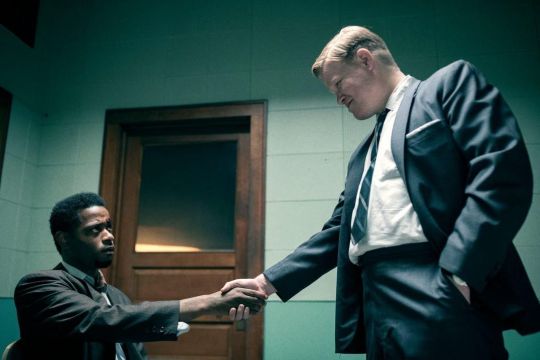
LaKeith Stanfield (left) as William O’Neal and Jesse Plemons (right) as FBI agent Roy Mitchell
(Glen Wilson / Warner Bros.)
What events does Judas and the Black Messiah dramatize?
Set between 1968 and 1969, King’s film spotlights Hampton’s accomplishments during his brief tenure as chapter chairman before delving into the betrayals that resulted in his death. Key to Hampton’s legacy were the Panthers’ survival programs, which sought to provide access to “fundamental elements of life,” per Pretzer. Among other offerings, the organization opened free health clinics, provided free breakfasts for children, and hosted political education classes that emphasized black history and self-sufficiency. (As Hampton said in 1969, “[R]eading is so important for us that a person has to go through six weeks of our political education before we can consider [them] a member.”)
On an average day, Hampton arrived at the Panthers’ headquarters with “a staccato of orders [that] gave energy to everyone around him,” says Haas. “But it wasn’t just what he asked people to do. He was there at 6:30 in the morning, making breakfast, serving the kids, talking to their parents.”
In addition to supporting these community initiatives—one of which, the free breakfast program, paved the way for modern food welfare policies—Hampton spearheaded the Rainbow Coalition, a boundary-crossing alliance between the Panthers, the Latino Young Lords, and the Young Patriots, a group of working-class white Southerners. He also brokered peace between rival Chicago gangs, encouraging them “to focus instead on the true enemy—the government and the police,” whom the Panthers referred to as “pigs,” according to the Village Free Press.
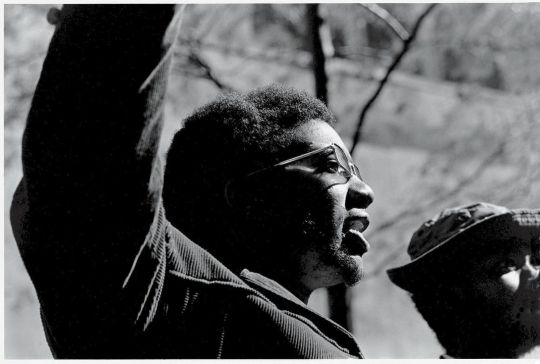
Fred Hampton raises his right hand at an October 11, 1969, rally in Chicago.
(Photo by David Fenton / Getty Images)
Speaking with Craig Phillips of PBS’ “Independent Lens” last year, historian Lilia Fernandez, author of Brown in the Windy City: Mexicans and Puerto Ricans in Postwar Chicago, explained, “The Rainbow Coalition presented a possibility. It gave us a vision for what could be in terms of interracial politics among the urban poor.”
Meanwhile, O’Neal was balancing his duties as an informant with his rising stature within the party. Prone to dramatic tendencies, he once built a fake electric chair intended, ironically, to scare informers. He also pushed the Panthers to take increasingly aggressive steps against the establishment—actions that led “more people, and Fred in particular, [to become] dubious of him,” says Haas.
The months leading up to the December 1969 raid found Hampton embroiled in legal troubles as tensions mounted between police and the Panthers. Falsely accused of theft and assault for the July 1968 ice cream truck robbery, he was denied bail until the People’s Law Office intervened, securing his release in August 1969. Between July and November of that year, authorities repeatedly clashed with the Panthers, engaging in shootouts that resulted in the deaths of multiple party members and police officers.

Daniel Kaluuya as Fred Hampton (far left) and LaKeith Stanfield as William O’Neal (far right)
(Glen Wilson / Warner Bros.)
By late November, the FBI, working off O’Neal’s intel, had convinced Cook County State’s Attorney Edward Hanrahan and the Chicago Police Department to raid Hampton’s home as he and his fiancée Johnson, who was nine months pregnant, slept. Around 4:30 a.m. on December 4, a heavily armed, 14-person raiding party burst into the apartment, firing upward of 90 bullets at the nine Panthers inside. One of the rounds struck and killed Mark Clark, a 22-year-old Panther stationed just past the front door. Though law enforcement later claimed otherwise, the physical evidence suggests that just one shot originated within the apartment.
Johnson and two other men tried to rouse the unconscious 21-year-old Hampton, who’d allegedly been drugged earlier that night—possibly by O’Neal, according to Haas. (O’Neal had also provided the cops with a detailed blueprint of the apartment.) Forced out of the bedroom and into the kitchen, Johnson heard a cop say, “He’s barely alive. He’ll barely make it.” Two shots rang out before she heard another officer declare, “He’s good and dead now.”
What happened after Hampton’s assassination?
Judas and the Black Messiah draws to a close shortly after the raid. In the film’s final scene, a conflicted O’Neal accepts an envelope filled with cash and agrees to continue informing on the Panthers. Superimposed text states that O’Neal remained with the party until the early 1970s, ultimately earning more than $200,000 when adjusted for inflation. After he was identified as the Illinois chapter’s mole in 1973, O’Neal received a new identity through the federal witness protection program. In January 1990, the 40-year-old, who’d by then secretly returned to Chicago, ran into traffic and was struck by a car. Investigators deemed his death a suicide.
“I think he was sorry he did what he did,” O’Neal’s uncle, Ben Heard, told the Chicago Reader after his nephew’s death. “He thought the FBI was only going to raid the house. But the FBI gave [the operation] over to the state’s attorney and that was all Hanrahan wanted. They shot Fred Hampton and made sure he was dead.”
The attempt to uncover the truth about Hampton and Clark’s deaths began on the morning of December 4 and continues to this day. While one of Haas’ law partners went to the morgue to identify Hampton’s body, another took stock of the apartment, which the police had left unsecured. Haas, meanwhile, went to interview the seven survivors, four of whom had been seriously injured.
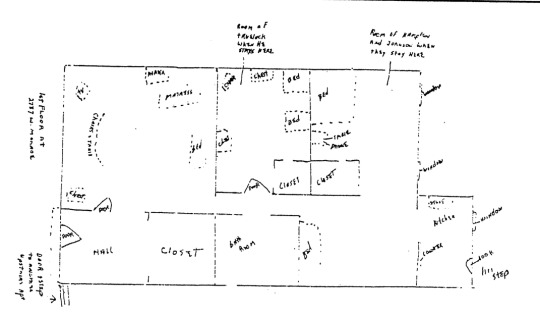
A floor plan of Fred Hampton’s apartment provided to the FBI by William O’Neal
(People’s Law Office)
Hanrahan claimed that the Panthers had opened fire on the police. But survivor testimony and physical evidence contradicted this version of events. “Bullet holes” ostensibly left by the Panthers’ shots were later identified as nail heads; blood stains found in the apartment suggested that Hampton was dragged out into the hallway after being shot in his bed at point-blank range.
Public outrage over the killings, particularly within the black community, grew as evidence discounting the authorities’ narrative mounted. As one elderly woman who stopped by the apartment to see the crime scene for herself observed, the attack “was nothing but a Northern lynching.”
Following the raid, Hanrahan charged the survivors with attempted murder. Haas and his colleagues secured Johnson’s release early enough to ensure she didn’t give birth to her son, Fred Hampton Jr., in jail, and the criminal charges were eventually dropped. But the attorneys, “not content with getting people off, decided we needed to file a civil suit” alleging a conspiracy to not only murder Hampton, but cover up the circumstances of his death, says Haas.
Over the next 12 years, Haas and his colleagues navigated challenges ranging from racist judges to defendants’ stonewalling, backroom deals between the FBI and local authorities, and even contempt charges brought against the attorneys themselves. Working from limited information, including leaked COINTELPRO documents, the team slowly pieced together the events surrounding the raid, presenting compelling evidence of the FBI’s involvement in the conspiracy.

Hampton’s fiancée, Deborah Johnson (sitting in middle, as portrayed by Dominique Fishback), gave birth to their son, Fred Hampton Jr., 25 days after the raid.
(Glen Wilson / Warner Bros.)
Though a judge dismissed the original case in 1977 following an 18-month trial, Haas and the rest of the team successfully appealed for a new hearing. In 1982, after more than a decade of protracted litigation, the defendants agreed to pay a settlement of $1.85 million to the nine plaintiffs, including Clark’s mother and Hampton’s mother, Iberia.
“I used to describe being in court like going to a dog fight every day,” says Haas. “Everything we would say would be challenged. The [defendants’ lawyers] would tell the jury everything the Panthers had ever been accused of in Chicago and elsewhere, and [the judge] would let them do that, but he wouldn’t let us really cross examine the defendants.”
Hampton’s death dealt a significant blow to the Illinois chapter of the Black Panther Party, frightening members with its demonstration of law enforcement’s reach and depriving the movement of a natural leader.
According to Pretzer, “What comes out is that the the assassination of Hampton is a classic example of law enforcement’s malfeasance and overreach and … provoking of violence.”
Today, says Haas, Hampton “stands as a symbol of young energy, struggle and revolution.”
The chairman, for his part, was keenly aware of how his life would likely end.
As he once predicted in a speech, “I don’t believe I’m going to die slipping on a piece of ice; I don’t believe I’m going to die because I got a bad heart; I don’t believe I’m going to die because of lung cancer. I believe that I’m going to be able to die doing the things I was born for. … I believe that I will be able to die as a revolutionary in the international revolutionary proletarian struggle.”
#History
5 notes
·
View notes
Text
Birthdays 7.29
Beer Birthdays
Max Schwarz (1863)
Garrett Oliver (1962)
Five Favorite Birthdays
Ken Burns; documentary filmmaker (1953)
Geddy Lee; rock bassist, singer (1953)
William Powell; actor (1892)
Dave Stevens; artist, cartoonist, illustrator (1955)
Wil Wheaton; actor, blogger (1972)
Famous Birthdays
Afroman; rapper (1974)
Jean-Hugues Anglade; French actor and director (1955)
Doug Ashdown; Australian singer-songwriter (1942)
Porfirio Barba-Jacob; Colombian poet and author (1883)
Melvin Belli; attorney (1907)
Clara Bow; actor (1905)
Danger Mouse; cartoon character (1977)
Don Carter; bowler (1926)
John Clarke; New Zealand-Australian comedian and actor (1948)
Edgar Cortright; scientist and engineer (1923)
Professor Irwin Corey; comedian, actor (1914)
Sharon Creech; author (1945)
Simon Dach; German poet (1605)
Alex de Tocqueville; French writer, historian, political scientist (1805)
Stephen Dorff; actor (1973)
Neal Doughty; keyboard player (1946)
Leslie Easterbrook; actress (1949)
Richard Egan; actor (1921)
Adele Griffin; author (1970)
Tim Gunn; fashion consultant, television host (1953)
Dag Hammarskjold; Swedish diplomat (1905)
Betty Harris; chemist (1940)
Jenny Holzer; painter, author, and dancer (1950)
Robert Horton; actor (1924)
Isabel; Brazilian princess (1846)
Peter Jennings; television journalist (1938)
Eyvind Johnson; Swedish novelist (1900)
Joe Johnson; English snooker player (1952)
Diane Keen; English actress (1946)
Eric Alfred Knudsen; author (1872)
Harold W. Kuhn; mathematician (1925)
Stanley Kunitz; poet (1905)
Don Marquis; cartoonist, writer (1878)
Jim Marshall; guitar amplifier maker (1923)
Martina McBride; country singer (1966)
Daniel McFadden; economist (1937)
Frank McGuinness; Irish poet and playwright (1953)
Goenawan Mohamad; Indonesian poet and playwright (1941)
Harry Mulisch; Dutch author, poet (1927)
Benito Mussolini; Italian journalist and politician (1883)
Gale Page; actress (1910)
Alexandra Paul; actor (1963)
Dean Pitchford; actor and director (1951)
Isidor Isaac Rabi; physicist (1898)
Don Redman; composer (1900)
Sigmund Romberg; Hungarian-American composer (1887)
Mahasi Sayadaw; Burmese monk and philosopher (1904)
Patti Scialfa; musician (1954)
Mary Lee Settle; novelist (1918)
Tony Sirico; actor (1942)
Randy Sparks; folk singer-songwriter (1933)
John Sykes; English singer-songwriter and guitarist (1959)
Booth Tarkington; writer (1869)
David Taylor; English snooker player (1943)
Paul Taylor; dancer (1930)
Mikis Theodorakis; Greek composer (1925)
Didier Van Cauwelaert; French author (1960)
David Warner; English actor (1941)
Woody Weatherman; guitarist (1965)
Vladimir K. Zworykin, Russian-American engineer and inventor (1888)
0 notes
Text
UPDATE FROM JURY: Jury asked if the verdict form was referring to #AmberHeard's entire OpEd or just the headline. Amber Heard previously spoke on this, stating, “I spoke up against s3xu@l violence -- and faced our culture's wrath. That has to change."
During the #JohnnyDeppVsAmberHeardTrial, the jury did hear Amber say that she experienced SA by #JohnnyDepp using a bottle...so there's that.
However, the #johnnydepptrial jury is likely considering whether there's any evidence (and EVIDENCE is the key word we, and the jury, are looking at here) that Amber was SA by #Depp, which the jury will invariably answer in the NEGATIVE.
Follow along for more #amberheardjohnnydepp updates on this #defamationtrial!
#justice for johnny#daniel r warner#daniel r warner attorney#daniel warner#daniel warner attorney#rm warner law#rmwarnerlaw#defamation#defamation lawsuit#defamationofcharacter#defamation johnny depp#johnny depp vs amber heard#johnnydepp#heard amber#amber turd#depp v heard#johnny depp trial#amber heard
4 notes
·
View notes
Text
“Just Mercy” (2019)
Rating, 137 minutes, directed by Destin Daniel Cretton, written by Destin Daniel Cretton and Andrew Lanham, based on the memoir by Bryan Stevenson
Warner Brothers made the movie free to stream on (all?) digital storefronts for the month of June 2020.
Notable performers: Michael B. Jordan is so very compelling. Jamie Foxx perfectly portrays a man defeated by the system. (Special shout out to Brie Larson who leans very heavily into the early 90s aesthetic of this period piece, and also is very compelling.)
Why you should watch it in general: It’s a true story that more people should know about.
Why you should watch it while you’re stuck at home: You can watch it for free!
Is it part of a franchise: No.
Have I seen it before: No.
Does the trailer do it justice: Yes.
There’s so many disturbing acts of racism in this movie. A movie that’s based on actual events.
Jordan plays Bryan Stevenson, a lawyer who decides to dedicate himself to providing legal representation to those who can’t afford proper representation. The story focuses on Walter “Johnny D” McMillian (Jamie Fox). A Black man convicted of murdering a young White woman. The case hinges upon the testimony of one known felon. Meanwhile, Johnny D had two dozen witnesses, including a police officer, who knew he was across town at a church fish fry and definitively did not commit the murder (including the fact that his truck was non-functional the day of the murder and his truck plays heavily into the narrative of the “witness” whose testimony got him convicted). The problem? All the people who could have been his alibi were also all Black, so none of the racist assholes from the local police or the district attorney (also a racist asshole) cared to actually investigate and get the actual facts. Oh, and we find out - not really a surprise - that the known felon whose testimony got Johnny D sent to jail was coerced (basically tortured) into framing Johnny D (after he initially refused to frame a man for murder).
It’s compelling. It’s sad. It’s true. Which makes it even sadder. Like, WTF is wrong with people? (That’s rhetorical, I know racism is a terrible system of oppression that’s baked right into the fabric of this country.)
Have your tissues ready.
youtube
13 notes
·
View notes